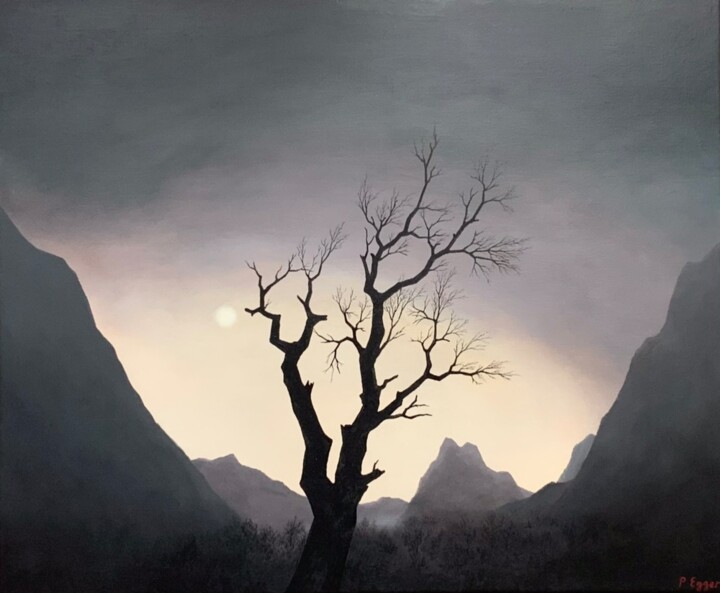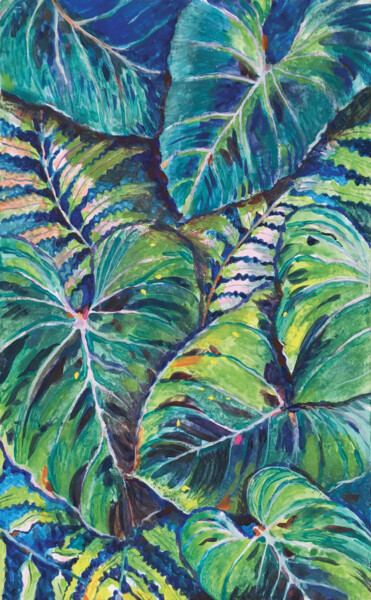Lone trees, accompanied trees, witnessing trees...
"Some trees near houses
stand in a tilted peace
as if indicating, as if calling
us, the restless, the distracted
inhabitants of the world. Some trees
stand patiently. Close
to our rooms where we sometimes cry out
for a togetherness
that harbors the storm
we who devastate beloved faces
for a law of tears."
-Mariangela Gualtieri"
We would need a thousand more poems, because if this last one places trees next to houses, other times they seem alone, or accompanied by figures or animals, and sometimes even as mute and immobile spectators of 'fantastic' events, just like those narrated in the Bible or in religion in general. This is where art comes in, which, instead of poetry, immortalizes the situations just described through masterpieces that have turned the said plant into a rather popular presence in figurative storytelling. Let's start by revealing some works that have the tree as their main subject, and then we'll continue by adding houses, people, and animals, culminating in those scenes where nature bears witness to events ordained by God... Speaking of solitary trees or trees in the company of others, let's begin with the solitary, white, dry, and earthy protagonist of Egon Schiele's 'Small tree in late autumn' (1911), a painting that depicts a bare tree atop a hill exposed to autumn winds, transforming nature into a reflection of the artist's psychological states. In fact, if we carefully observe the trunk, along with the branch protruding to the right, they remind us of the features of a thin figure, apparently dancing or in motion, deciding to isolate itself on a hill to defy the wind, despite its natural and futile impotence. Adding three companions to our adventurous tree, we have the iconic 'Four Trees' (1917), a painting by the same master. Its peculiarity lies in the foreground dark trees standing against a landscape illuminated by a sunset that only brightens the distant mountains and the sky above them. Offering another psychological interpretation of what has just been described, many art historians argue that the two trees at the ends of the canvas appear stronger than those in the center, as if alluding to the master's belief that artists, often on the fringes of society, sometimes find more happiness than those who forcibly choose a more conservative path. Now it's time to add houses to the trees, and I will do so by mentioning the work of the iconic Picasso, the creator of 'La Rue des Bois' (1908), a landscape meant to immortalize the tiny locality just outside Paris, which, densely wooded, is avidly dominated by the presence of trees, which, accompanied by architectural forms, draw extensive inspiration from the work of Paul Cézanne, a stylistic fact evident both in the forms and the colors of the work in question.
 SAGA OF THE TREES 1 (2022)Painting by Alla Ronikier.
SAGA OF THE TREES 1 (2022)Painting by Alla Ronikier.
 REFLECTION 10 (2020)Painting by Ella Joosten.
REFLECTION 10 (2020)Painting by Ella Joosten.
 IT'S BACK TO SCHOOL (2023)Painting by Alexandra Battezzati.
IT'S BACK TO SCHOOL (2023)Painting by Alexandra Battezzati.
Now let's replace houses with the human figure, merging trees and characters into a single keyword for a specific database, capable of leading us to the citation of 'Abraham's Oak,' a painting by American artist Henry Ossawa Tanner. It aimed to immortalize the very place where, under the gaze of an oak tree, Adam pitched his tent and built an altar to God. The location in question, situated in the Middle East, was indeed visited by the artist, but he found a severely declining oak tree there. To paint it, he referred to a painting by Johann Friedrich Perlberg, an example he interpreted in a nocturnal scene, enriched by the presence of two individuals captured while walking in the moonlight. Finally, in accordance with writer Stephanie Brommer, the work 'radiates a mystical peace and spirituality with the pale light of the moon and the symbolism of the oak, a majestic reminder of Abraham's years in Canaan centuries ago.' We have now reached the combination of trees and animals, which could not find a better example than in the rich interpretations of Jan van Kessel the Elder, a Flemish painter active in the mid-17th century. He was extremely well-known for reviving trees by placing colorful birds on each of their branches. In fact, the master specialized in creating small-scale paintings mainly inspired by fauna, which were extremely detailed. The painter referred to the precision of illustrated scientific treaties of the time, aiming to transform art into a comprehensive study, including insects and reptiles, as well as flowers and rare objects from various regions of the known world. However, it is important to emphasize that in creating the above, van Kessel distinguished himself with a more detached approach from his predecessors. He gave great importance to composition and aesthetics, often arranging species as if they were specimens in a collector's cabinet. Flemish art has finally brought us to the conclusion of this narrative, which culminates in the religious event depicted by Giotto in 'The Sermon to the Birds,' a masterpiece in which the saint in question, St. Francis, stops on his way to Bevagna to deliver the word of God to a flock of birds that suddenly surrounded him. All of this happens under the 'eyes,' or rather the branches, of two trees placed at the ends of the support, conceived by the artist to synthesize the landscape in which the sacred scene takes place. The story about trees has finally reached this point to continue into contemporary times through the work of the artists of Artmajeur...
 HIBERNATION 2/3 (2023)Photography by Bettina Dupont.
HIBERNATION 2/3 (2023)Photography by Bettina Dupont.
Bettina Dupont: HIBERNATION 2/3
A misty landscape is "lit up" by the red of a flowery meadow, whose shades are echoed in the autumn leaves of a tree placed in the center of the photographic support. However, our attention is decidedly captured by the images of large eggs arranged at its "feet" (roots). These "containers of life" may have fallen from nests, probably located on the crown of the tree, although the eggs in question appear too large and heavy to be supported by such fragile branches. The vision becomes even more mysterious when, looking at the eggs, we notice the existence of open ones, leading us to wonder about the creatures that have emerged from them, perhaps imagining the advent of a new species, closely related to smaller dinosaur breeds. However, what appears to be more understandable is the possible meaning of the tree figure, which, as a symbol of growth, decay, and resurrection par excellence, could allude to the ancient concept of the Cosmic Tree, aimed at identifying the plant as a kind of connection between heaven and earth, realized through the extensions of its branches (sky) and its roots (earth). Similar to what has just been explained is the figure of the Tree of Life, an emblem of knowledge, the world, and life, which, in Bettina's work, finds concrete realization in the image of the natal and prenatal egg.
 SUNLIT PINES (2020)Painting by Gary Westall.
SUNLIT PINES (2020)Painting by Gary Westall.
Gary Westall: SUNLIT PINES
Referring to the artist's words, the work in question was born from the observation of the pines of Lower Saxony (Germany), specifically those of the Kirchdorfer Heide nature reserve, near the painter's studio. Westall adds that he wanted to portray this subject in particular because he was impressed by how it was "caressed" by the sun, generating chromatic contrasts between the blue sky and the brown, partly orange-brown, of the tall, slender trunks. For my part, contemplating this work, halfway between realism and impressionism, makes me think of the ways in which the tree has been depicted in the long history of art, which I will try to summarize briefly here. So, in the Middle Ages and the Renaissance, this plant was mainly associated with Christian themes, primarily that of Original Sin. During the 16th and 17th centuries, however, landscape painting was born, a genre in which artists began to take an interest in different species. Later, artists like Rembrandt, Rubens, and Gainsborough attributed dramatic, melancholic, and typical autumnal warmth to the tree. The tree structure was instead used with great effect by Titian, so much so that his groupings of plants were continued in the works of Annibale Carracci, Poussin, and Claude. However, the situation changed drastically between the 18th and 19th centuries, when art began to exploit the image of the tree in a myriad of different ways...
 ENDURANCE (2023)Painting by Patrick Egger.
ENDURANCE (2023)Painting by Patrick Egger.
Patrick Egger: ENDURANCE
The words chosen by the Artmajeur artist to accompany the title, which is already quite revealing of the ultimate meaning of the depicted subject, are: "the resilience of a tree that retreats into the few old branches still alive, despite the harsh conditions of the mountain...". What has just been exposed actually makes us reflect on the well-known resilience of the plant in question, which, every year, stands proudly, despite the loss of its perhaps beloved leaves, aware that moments of rebirth will surely come, making its bare branches green again. However, I've come up with a trick to add other possible meanings to the work in question, which I decided to relate to a masterpiece of art history, starting with its title. In fact, Egger's painting, given its subject, could change its name to "The Lonely Tree," taking on the title given by Caspar David Friedrich to one of his canvases from 1822, which features an isolated tree in a green, mountainous landscape as the protagonist. To further strengthen the similarities between the works in question, the meaning of Friedrich's painting also alludes to the courage of an old oak, now damaged and endangered by some threatening clouds that form a sort of dome over its canopy. What sets the paintings apart, however, is, in addition to the landscape perspective, the presence, in the case of "The Lonely Tree," of a shepherd who takes shelter under the leaf-covered branches, from where he safely observes his flock.


 Olimpia Gaia Martinelli
Olimpia Gaia Martinelli























